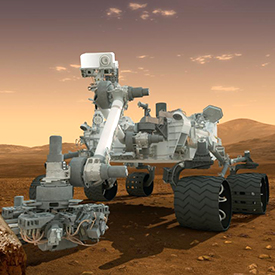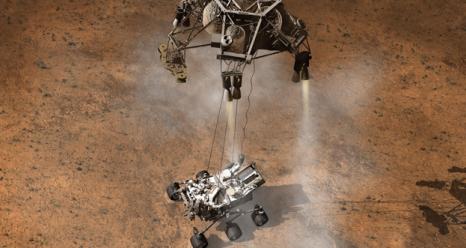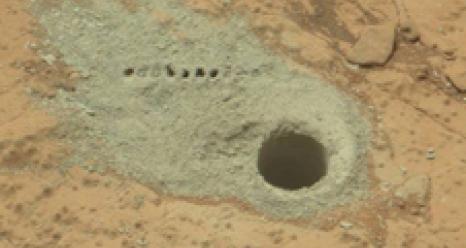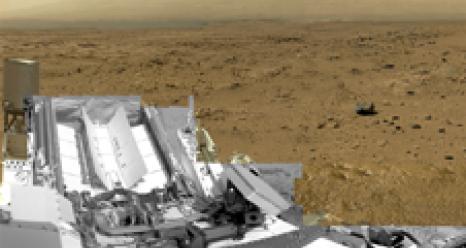Mars Curiosity is a car-sized robotic rover that is exploring Mars. It is a centerpiece mission in NASA’s Mars Science Laboratory program, which is the most ambitious mission to explore the red planet. Curiosity is the largest rover to explore this planet. In this article, we explore details of this mission including whether there are signs that Mars can support life in the present or could have supported life in the past.

Mars Curiosity Purposes
The main purpose is to find out if Mars is or was suitable for life now or in the past. It will do this by investigating whether conditions that support life exist now and searching for signs that conditions that are necessary for life existed in the past. For example, the rover will explore the presence of water on Mars, which is necessary for life. It will find out how long water has existed in liquid form on the planet and whether its acidity level could support life. It will also explore the Martian environment.
Gale Crater was chosen as the landing site for this rover because the mountain surrounding this crater is made up of geological layers that are very old. They believe that flowing water left channels in the layers on the walls. Curiosity is expected to explore these layers. Astronomers believe these layers could reveal more about Mar’s past just as the layers in the wall of the Grand Canyon revealed information about Earth’s past.
Mars Curiosity Landing

After travelling for eight months, Mars Curiosity finally reached the red planet and landed on the Martian surface on 5 August 2012. Gale Crater, a position near the equator had been chosen as the landing site because of the variation in its terrain. The entry, descent and landing went smoothly as planned.
The mission was intended to last two years but there were possibilities of it being extended, as the equipment would last longer than this. Later, it was extended indefinitely so the rover will continue exploring Mars. Scientists hope that the rover will climb Aeolis Mons (Mount Sharp), which is near the landing site.
Since the landing, the rover has operated smoothly. It experienced its first major glitch in February 2013 when a computer error put the rover in safe mode for a few days, interrupting normal science activities but with no effect on its long-term capability.
Mars Curiosity Instruments
The Mars Curiosity rover is equipped with powerful instruments to ensure it achieves its mission. It has 17 cameras and 10 different science instruments.
There are two radiation detectors onboard. The Radiation Assessment Detector (RAD) measures high-energy radiation on Mars originating from space or emitted from its surface or atmosphere. This will help astronomers find out the radiation exposure risks in preparation for future human exploration of the red planet.
The Dynamic Albedo of Neutrons (DAN) instrument looks for water on Mars. When cosmic rays coming from space bombard Mars, they knock neutrons out of atoms but hydrogen atoms in water slow down the neutrons. DAN can detect slowed neutrons and therefore detect the presence of water.
The Rover Environmental Monitoring Station (REMS) sensor measures and reports the atmospheric conditions on Mars including Temperature, wind speed, pressure, humidity and ultraviolet radiation level.
The rover is equipped with three cameras. MastCam captures color images and videos that display a panoramic view of the rover’s surrounding inside the crater. MARDI recorded a video of the rover as it descended into the planet. Mars Hand Lens Imager (MAHLI) will capture close-up photos of the rock and dust enabling geologists to study minerals found on Mars.
There are four spectrometers. Alpha Particle X-Ray Spectrometer (APXS) will examine the rock and soil samples to find out the composition of the terrain, which will help astronomers learn how the materials were formed and affected by the elements on Mars. The Sample Analysis at Mars spectrometer (SAM) searches for carbon, nitrogen, hydrogen and oxygen, which are all elements associated with life in the universe. ChemCam examines the minerals and rock microstructures by firing a laser into the terrain and analyzing the vaporized remains. Chemistry and Mineralogy instrument (CheMin) will find and characterize the minerals here to search for signs or water and determine whether Mars can or could have supported life.
Has The Mars Curiosity Found Signs of Life on Mars?
Mars Curiosity has accomplished some major feats so far. Since it is still in operation, there are possibilities that the rover will uncover more about Mars ability to support life. Here are some of its accomplishments and discoveries so far.
The first major accomplishment was the smooth and safe landing. The landing was very complicated due to the rover’s weight and complicated maneuvers were involved. The landing was so complicated that it was referred to as `seven minutes of terror’.
Thousands of people gathered at the New York’s Times Square to watch the landing. Once the waiting ordeal was over, the engineers on Earth were very excited and the event received wide coverage in the news. The Mars Curiosity even has a twitter account where millions of followers get updates on the rover’s status.
Its Mars Entry Descent and Landing Imager gathered information as the spacecraft descended on Mars atmosphere. This information will be useful in planning future human missions to Mars to achieve safer and more reliable entries. The Curiosity Rover’s design will inspire the unmanned 2020 Mars rover mission planned by NASA.
In preparation for manned explorations to Mars, the rover has determined the radiation on Mars to be similar to the one experienced by the crewmembers working and living in the International Space Station.
The rover found an ancient streambed where water may have flowed in the ancient past at a spot known as Yellowknife Bay near its landing site. This could be a sign that Mars was habitable in the distant past.
The Curiosity rover was able to drill into Martian rocks to obtain samples and study the ancient conditions. The samples contained sulfur, nitrogen, hydrogen, oxygen, phosphorous and carbon, all of which are key ingredients to life. Even though this is not evidence of life, astronomers were very excited, as this is a sign that mars could have supported microbial life in the past.

The Curiosity rover has also captured highly detailed images of the Martian surface. The rover captured a 1.3 billion-pixel image of a site referred to as Rocknest where the rover collected its first soil samples. Mount Sharp appears in this highly detailed image. These images make it possible to examine the captured part of the Red Planet in incredible detail.

